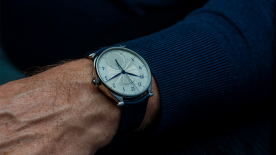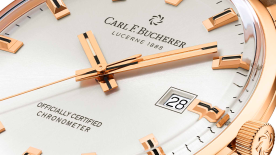Dossier : What’s next ?
In this mini-series of features inspired by the theme of the 2014 Forum de la Haute Horlogerie, we consider different scenarios that will affect the future of the watch industry and its customers, from the ever-increasing importance of digital to the customers of tomorrow and even the need to just slow down.
Diana Verde Nieto is the co-founder of Positive Luxury, the company behind the Butterfly Mark - the interactive Trust Button that’s revolutionising the way consumers interact with brands. The Butterfly Mark uses cutting edge technology to update consumers on a company’s best practices and in turn keeps those companies up to date with their consumers’ views - from what makes a brand trustworthy to enhancing the consumer experience. In just three years, the company has developed a client base of over 300 brands.
WorldTempus: How did you come to focus on millennials through your work?
Diana Verde Nieto: My passion is sustainability but the concept was unsexy and words such as ‘ethical’ were off-putting. So I very quickly found out that I needed to find a different way to talk to the millennials about this in a way that was embracing and understanding rather than alienating. Technology is the perfect vehicle to do so.
Your company has developed a new social button to help brands with these millennials. Can you tell us more about it?
At the point of sale the Trust Button shows consumers that brand’s social, environmental and philanthropic actions. Consumers can then click to trust the brand and brands can ask the consumer any questions that they want, which makes the conversation very intimate. On the brand side we have a dashboard which captures all data from that interaction which brands can use to see what generates a return on investment.
Brands can use the Trust Button on not only their own site but on any other site that sells their products. IWC, DeBeers and Okapi are among the watch brands who are part of Positive Luxury’s membership programme.
Do you think the tradition-rich Swiss watch industry is compatible with the millennials?
Millennials can be anywhere between 14 and 33 years old, so they know about luxury and they understand luxury. But the luxury industry in general needs to change. Millennials are looking for a different type of luxury that is more open and has innovation at the centre of it.
They want an inclusive form of luxury. By their very nature they work in packs, so it is all about sharing. They are looking for a kind of inclusive exclusivity. For them, luxury is not about showing that they have achieved something, it is more about buying luxury because of what they CAN achieve.
These people live through the screen. It’s not online or offline, or above the line or below the line – there is no line.
Luxury has the biggest opportunity with the millennials because quality and durability are very important to them. Because money is tight they want to invest it rather than just spend it.
Millennials want the luxury lifestyle but they want brands to represent who they want to be. And the only way to find out what this means is through technology because they are glued to their mobiles.

Some watch brands shun social media completely. What advice do you have for them?
First of all, I specifically don’t talk about social media in my presentations because it is becoming a channel, just like radio, TV or print. People under the age of 25 are unlikely to be on Facebook, for example. Young people are more interested in peer-to-peer communication, so they are looking to Skype, Facetime, Pinterest or Instagram. This is how they are communicating: the world through images.
Luxury brands need to be transparent. One of the best examples is Louis Vuitton, which is starting to talk about all aspects of the brand, from the product to corporate social responsibility. Sustainability used to be an after-thought, but just as digital is now at the very heart of a brand’s communications, social and environmental good should be too.






